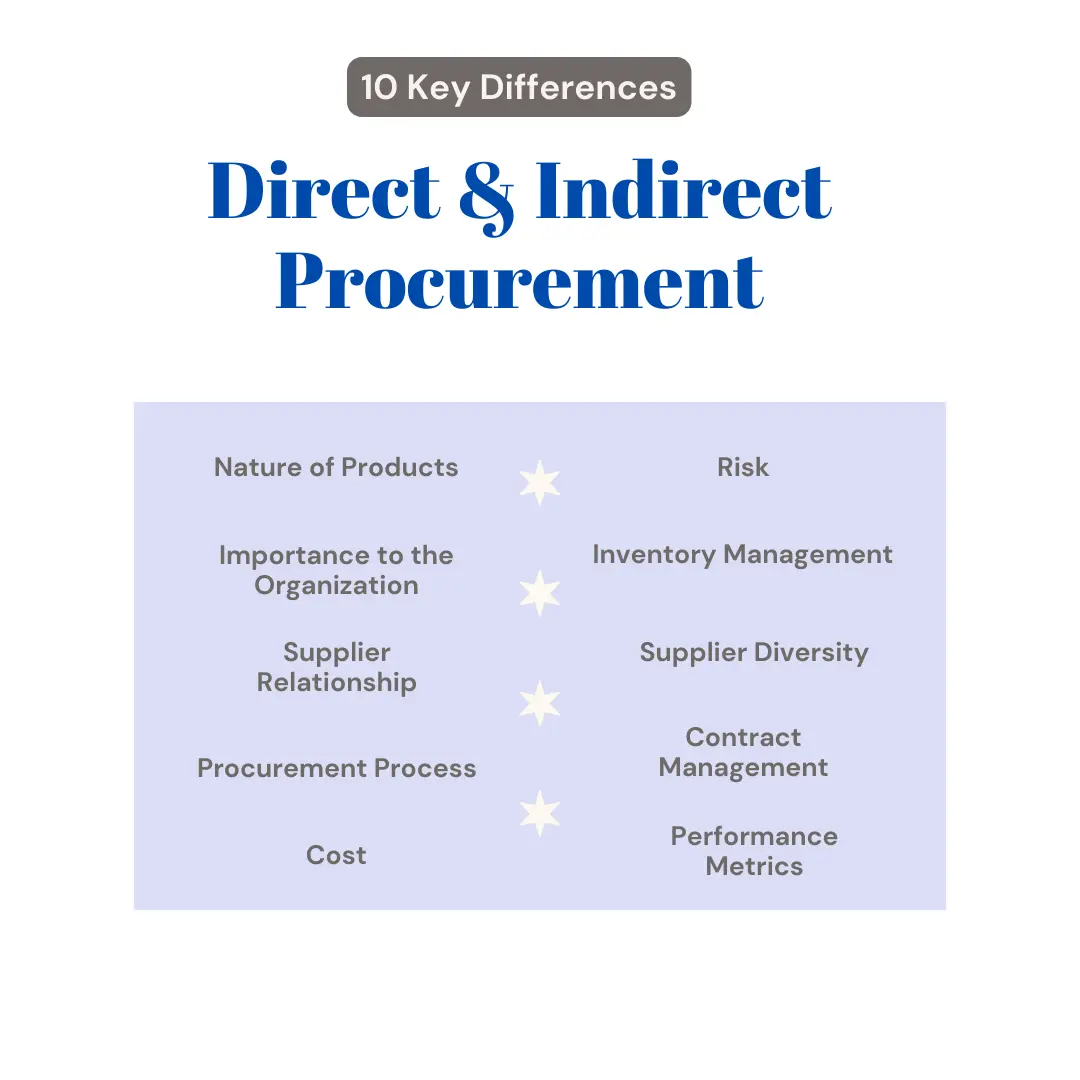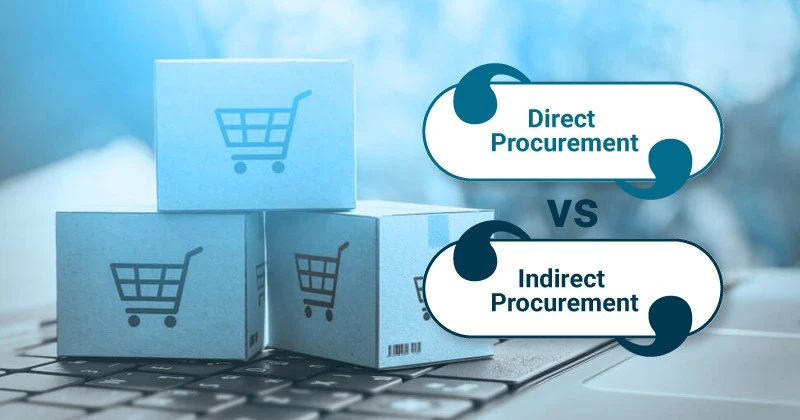Direct and Indirect Procurement: 10 Key Differences to Know
Procurement is a critical function for any organization, and it can be broadly classified into two categories: direct and indirect procurement. Both types of procurement involve purchasing goods and services, but they differ in terms of the nature of the products and the way they are acquired. In this blog, we will explore the key differences between direct and indirect procurement.
Before diving into their differences, lets understand the terminologies:
Defining Direct and Indirect Procurement
Direct Procurement:
Direct procurement, also known as production procurement, involves the purchase of goods and services that are directly used in the production process or are essential for the manufacturing of a company’s final products.
These are typically items that are directly related to the core business activities of the organization.
Examples of direct procurement items include raw materials, components, machinery, equipment, and specialized tools required for manufacturing.
Direct procurement is critical for ensuring the production process runs smoothly and efficiently, and any disruptions in the supply chain can directly impact product quality and delivery.
Indirect Procurement:
Indirect procurement, also known as non-production procurement or indirect spend, involves the purchase of goods and services that are not directly used in the production process but are essential for the overall operation of the business.
These items are typically considered overhead or support items that enable the organization to function smoothly.
Examples of indirect procurement items include office supplies, maintenance and repair services, IT equipment and software, janitorial services, and employee training.
Indirect procurement is focused on optimizing cost-effectiveness, supplier relationships, and process efficiency, as these items do not directly impact the end product but can have a significant impact on overall operational costs.
10 key differences between direct and indirect procurement

1. Nature of Products
Direct procurement involves the purchase of goods and services that are directly related to the production process of the organization. These products are used in the manufacturing or assembly of the final product. Examples of direct procurement include raw materials, machinery, and components.
Indirect procurement, on the other hand, involves the purchase of goods and services that are not directly related to the production process. These products are used in the day-to-day operations of the organization. Examples of indirect procurement include office supplies, IT services, and marketing services.
2. Importance to the Organization
Direct procurement is critical to the organization’s production process, and any disruption in the supply chain can have a significant impact on the organization’s ability to deliver its products. Indirect procurement, while important, is not as critical to the organization’s operations.
3. Supplier Relationship
Direct procurement involves a closer relationship with suppliers as the organization relies on them for the timely delivery of critical goods and services. Indirect procurement, on the other hand, involves a less close relationship with suppliers as the products are not as critical to the organization’s operations.
4. Procurement Process
The procurement process for direct procurement is more complex and time-consuming as it involves negotiating contracts, managing supplier relationships, and ensuring timely delivery of goods and services. Indirect procurement, on the other hand, involves a simpler procurement process as the products are not as critical to the organization’s operations.
5. Cost
Direct procurement is typically more expensive than indirect procurement as the products are critical to the organization’s production process and require a higher level of quality. Indirect procurement, on the other hand, is less expensive as the products are not as critical to the organization’s operations.
6. Risk
Direct procurement involves a higher level of risk as any disruption in the supply chain can have a significant impact on the organization’s ability to deliver its products. Indirect procurement, on the other hand, involves a lower level of risk as the products are not as critical to the organization’s operations.
7. Inventory Management
Direct procurement requires effective inventory management as the organization needs to ensure that it has the necessary raw materials and components to produce its products. Indirect procurement, on the other hand, requires less inventory management as the products are not as critical to the organization’s operations.
8. Supplier Diversity
Direct procurement involves a smaller pool of suppliers as the organization requires a higher level of quality and reliability from its suppliers. Indirect procurement, on the other hand, involves a larger pool of suppliers as the products are not as critical to the organization’s operations.
9. Contract Management
Direct procurement requires more extensive contract management as the organization needs to ensure that the supplier delivers the goods and services as per the agreed terms and conditions. Indirect procurement, on the other hand, requires less contract management as the products are not as critical to the organization’s operations.
10. Performance Metrics
Direct procurement involves more stringent performance metrics as the organization needs to ensure that the supplier delivers the goods and services as per the agreed quality and timelines. Indirect procurement, on the other hand, involves less stringent performance metrics as the products are not as critical to the organization’s operations.
Direct Procurement Pros
- Quality Control: Direct procurement allows for greater control over the quality and specifications of materials and components, ensuring that they meet the required standards for the final product.
- Cost Efficiency: By optimizing the sourcing and supply chain for critical production materials, businesses can reduce costs, improve cost predictability, and enhance overall production efficiency.
- Strategic Supplier Relationships: Direct procurement often involves long-term relationships with key suppliers, fostering collaboration and innovation to drive product improvement and cost reduction.
Direct Procurement Cons
- Supply Chain Vulnerability: Overreliance on a small number of suppliers for critical materials can create vulnerability to disruptions such as supply shortages or geopolitical issues.
- Complexity: Managing the procurement of specialized materials and components can be complex and requires skilled professionals and robust supply chain management systems.
- Higher Risk: Any issues with direct procurement can directly impact production and product quality, making it a higher-risk area compared to indirect procurement.
Indirect Procurement Pros
- Cost Savings: Indirect procurement allows organizations to consolidate purchases, negotiate volume discounts, and streamline processes, resulting in cost savings across a wide range of non-core spend categories.
- Process Efficiency: Standardizing procurement processes for indirect goods and services can improve efficiency, reduce administrative overhead, and enhance compliance with procurement policies.
- Focus on Core Operations: Indirect procurement frees up resources and time for the organization to focus on its core operations and strategic initiatives, rather than managing a multitude of non-core suppliers.
Indirect Procurement Cons
- Diverse Categories: Managing a wide variety of indirect spend categories can be challenging and may require a diverse skill set and specialized expertise.
- Supplier Fragmentation: Indirect procurement often involves a larger number of suppliers, leading to potential fragmentation and difficulty in supplier relationship management.
- Risk of Maverick Spending: Without proper controls, employees may make unauthorized purchases, leading to maverick spending and increased costs.
Conclusion
Direct and indirect procurement exhibit substantial variations across various aspects, to excel in procurement management, organizations must tailor their strategies and approaches based on these key differentiators, enabling them to effectively meet their unique procurement requirements and drive operational excellence. With automated RFQs, supplier management, and contract management, you can optimize efficiency and drive cost savings.
Book a meeting with our expert team to learn more and experience a live demo.
Authored by
Wendell Mendonca, Logistics Automation Consultant
